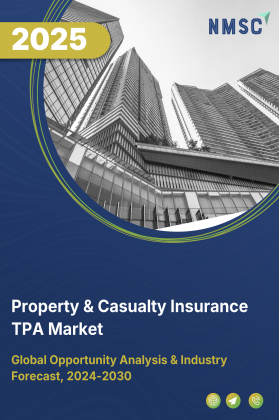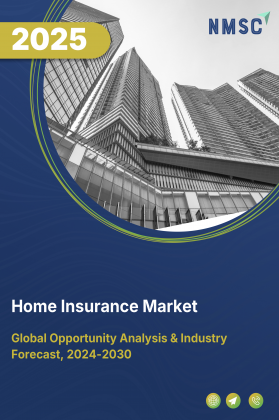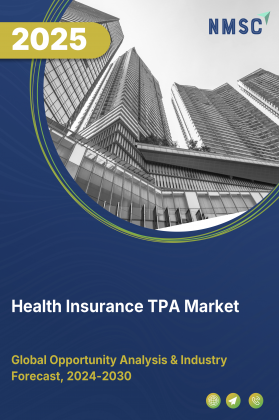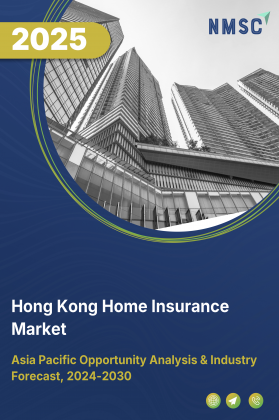
Property & Casualty Insurance TPA Market by Service Type (Claims Management, Policy Administration, Risk Management & Loss Control, Others), by Insurance Line (Property Insurance, Casualty Insurance), by Deployment (On-Premise TPA Systems, Cloud-Based TPA Platforms, Hybrid Models), and by End User (Insurance Companies, Self-Insured Organizations, Brokers, Others) – Global Opportunity Analysis and Industry Forecast, 2025–2030
Industry Outlook
The global Property & Casualty Insurance TPA Market size was valued at USD 141.55 billion in 2024, with an estimation of USD 152.92 billion in 2025 and is predicted to reach USD 184.33 billion by 2030 with a CAGR of 3.81% from 2025-2030.
The market is experiencing steady growth, driven by globalization of insurance, rapid adoption of technology, and a stronger focus on risk management. Multinational corporations and global insurers increasingly rely on TPAs to manage complex, cross-border claims with consistency and regulatory compliance. Advances in automation, artificial intelligence, and data analytics are transforming claims handling, enabling faster, more accurate, and cost-effective processes while enhancing customer experience.
At the same time, TPAs are expanding their role beyond claims administration to proactive risk mitigation, strengthening their value proposition. However, data security and privacy concerns remain a key restraint. Despite this, technology-driven innovation presents significant opportunities for the future property & casualty insurance TPA market expansion.
Globalization of Insurance Drives the Market Growth
The globalization of insurance is a major driver of the property & casualty insurance TPA market demand, as multinational corporations and global insurers increasingly require consistent claims management across multiple countries. Operating in diverse regulatory environments, with varying languages and legal frameworks, creates significant complexity that TPAs are uniquely positioned to address.
By providing localized expertise combined with centralized oversight, TPAs help insurers ensure compliance, reduce administrative costs, and deliver consistent customer service worldwide. This ability to manage cross-border claims efficiently makes globally capable TPAs an essential partner in today’s interconnected insurance landscape.
Technology and Automation Fuels Market Expansion
Technology and automation are reshaping the property & casualty insurance TPA market trends by enabling faster, more accurate, and cost-efficient claims handling. With rising claims volumes and pressure to improve turnaround times, insurers increasingly rely on TPAs that leverage artificial intelligence, data analytics, robotic process automation, and digital claims platforms.
These technologies help streamline routine tasks such as data entry, fraud detection, and document processing while improving accuracy and transparency. Automation also enhances customer experience by enabling real-time claim tracking, digital communication, and faster settlements. As a result, TPAs that invest in advanced technology and automation tools gain a competitive edge, driving overall market growth.
Growing Focus on Risk Management Boosts Market Demand
The growing focus on risk management is a key driver of the property & casualty insurance TPA market growth, as insurers and self-insured organizations seek proactive strategies to reduce losses and improve claims outcomes. Beyond traditional claims administration, TPAs increasingly offer services such as risk assessment, safety training, litigation management, and predictive analytics to identify potential risks before they escalate into costly claims.
This shift from reactive claims handling to proactive risk mitigation not only lowers overall claim costs but also strengthens compliance and improves long-term financial stability for insurers and employers. As risk management becomes a strategic priority in the insurance industry, TPAs with strong expertise and technology-driven risk control solutions are in higher demand.
Data Security and Privacy Concerns Limits the Market Growth
One major restraint of the property & casualty insurance TPA market is data security and privacy concerns. TPAs handle sensitive claimant information, including personal, financial, and medical data, which makes them prime targets for cyberattacks and data breaches. Any lapse in data protection result in significant financial losses, reputational damage, and regulatory penalties for both TPAs and their insurer clients.
Moreover, with stricter data privacy regulations such as GDPR in Europe and HIPAA in the U.S., compliance requirements add operational complexity and cost for TPAs. As insurers and clients grow more cautious about entrusting third parties with confidential data, security risks act as a barrier to widespread adoption of outsourced claims administration services.
Adoption of Advanced Analytics and Artificial Intelligence (AI) Creates New Growth Opportunities
A significant opportunity in the market lies in the adoption of advanced analytics and artificial intelligence (AI). With rising claims complexity and growing volumes of unstructured data, insurers are increasingly seeking partners that turn data into actionable insights. TPAs that invest in predictive analytics, machine learning, and AI-driven fraud detection help insurers identify patterns, reduce fraudulent claims, and forecast future risks more accurately.
This not only improves claims efficiency and reduces costs but also positions TPAs as strategic partners in decision-making rather than just service providers. As insurers push toward digital transformation, technology-enabled TPAs have a strong growth opportunity to differentiate themselves and capture a larger share of the market.
Market Segmentations and Scope of the Study
The property & casualty insurance TPA market report is segmented by service type, insurance line, deployment model, end-user and region. By service type, the market is divided into claims management, policy administration, risk management & loss control, and other services. By insurance line, the market covers property insurance, and casualty insurance. Based on deployment, the market is categorized into on-premise TPA systems, cloud-based TPA platforms, and hybrid models. By end-user, the market spans insurance companies, self-insured organizations, brokers, and others. Regional coverage includes North America, Europe, Asia-Pacific, and Rest of the World (RoW).
Geographical Analysis
In North America, one key driver of the property & casualty insurance TPA market share is the rising demand for workers’ compensation and liability claims management, particularly as employers face growing financial and workforce pressures. According to World at Work in 2025, a majority, about 56% of U.S. and Canadian employers reported that their workers are concerned about base pay increases due to recent global financial factors.
These concerns reflect the broader economic challenges that heighten the importance of effective claims cost control. As medical expenses, litigation risks, and regulatory complexity continue to rise, many employers and insurers are turning to TPAs for efficient workers’ compensation and liability claims handling, further driving market growth in the region.
In Europe, a key driver of the property & casualty insurance TPA market is the increasing complexity of cross-border insurance and regulatory requirements. With multinational corporations operating across the EU and beyond, insurers face diverse labor laws, compliance frameworks, and liability risks that require specialized claims handling.
Economic uncertainty has also intensified employee and employer concerns around costs and financial protection, similar to findings in North America where workers are sensitive to pay and benefits due to global financial pressures. In this environment, European insurers and self-insured organizations are increasingly relying on TPAs to deliver localized expertise, ensure regulatory compliance, and manage claims efficiently across multiple jurisdictions, fueling market growth.
In Asia-Pacific, the industry is being driven by rapid industry expansion and rising foreign investments in insurance. According to India Brand Equity Foundation (IBEF) in 2025, the insurance sector in India alone attracted over 62% of the USD 5.7 billion FDI into the services sector, highlighting strong global interest in the region’s insurance growth.
With 57 insurance companies in India, including 34 non-life insurers, the demand for efficient claims administration is increasing significantly. Similar trends across Asia-Pacific, driven by economic growth, urbanization, and stricter regulatory frameworks, are pushing insurers and self-insured organizations to partner with TPAs for scalable claims handling, compliance, and cost control.
Another key driver of the property & casualty insurance TPA market in the Rest of the World (RoW) is the increasing frequency of natural catastrophes and climate-related risks. Regions such as Latin America, the Middle East, and Africa are experiencing rising losses from floods, hurricanes, wildfires, and droughts, which significantly increase the number and complexity of claims.
Many local insurers lack the infrastructure to manage such large-scale, high-severity claims efficiently, prompting them to partner with TPAs that bring global expertise, technology, and scalable claims management capabilities. As climate risks continue to intensify, the need for specialized TPAs to support insurers with efficient catastrophe claims handling and risk mitigation strategies is expected to grow rapidly across RoW markets.
Strategic Innovations Adopted by Key Players
Key players in the property & casualty insurance TPA industry are advancing market growth through AI-driven innovations, risk management solutions, and predictive technologies.
-
In August 2025, CorVel supported The Save Mart Companies in achieving a 25% reduction in overall claims and notable decreases in frequent injury types, earning them the 2025 Workers’ Compensation Risk Management Award.
-
In May 2025, Crawford leaders discussed emerging risk trends in 2025, emphasizing predictive modeling for climate-related catastrophes and proactive workplace safety through wearables.
-
In April 2025, Sedgwick introduced Sidekick Agent, integrating Microsoft Azure OpenAI and document intelligence into claims workflows for real-time AI guidance to examiners.
-
In June 2024, Gallagher Bassett launched two advanced features, Waypoint Litigation Avoidance and Waypoint Return to Work, powered by AI to reduce litigation and lost workdays.
Key Benefits
-
The report provides quantitative analysis and estimations of the industry from 2025 to 2030, which assists in identifying the prevailing property & casualty insurance TPA market opportunities.
-
The study comprises a deep-dive analysis of the current and future property & casualty insurance TPA market trends to depict prevalent investment pockets in the industry.
-
Information related to key drivers, restraints, and opportunities and their impact on the market is provided in the report.
-
Competitive analysis of the key players, along with their market share is provided in the report.
-
SWOT analysis and Porters Five Forces model is elaborated in the property & casualty insurance TPA market study.
-
Value chain analysis in the market study provides a clear picture of roles of stakeholders.
Property & Casualty Insurance TPA Market Key Segments
By Service Type
-
Claims Management
-
Claim intake & registration
-
Claim adjudication & settlement
-
Others
-
-
Policy Administration
-
Underwriting support
-
Policy issuance & endorsements
-
Renewals & cancellations
-
Others
-
-
Risk Management & Loss Control
-
Risk assessment
-
Safety & loss prevention advisory
-
Others
-
-
Others
By Insurance Line
-
Property Insurance
-
Commercial property
-
Homeowners & personal property
-
Auto insurance
-
-
Casualty Insurance
-
General liability
-
Professional liability
-
Workers’ compensation
-
Cyber liability
-
By Deployment
-
On-Premise TPA Systems
-
Cloud-Based TPA Platforms
-
Hybrid Models
By End User
-
Insurance Companies
-
Self-Insured Organizations
-
Brokers
-
Others
By Region
-
North America
-
The U.S.
-
Canada
-
Mexico
-
-
Europe
-
The UK
-
Germany
-
France
-
Italy
-
Spain
-
Denmark
-
Netherlands
-
Finland
-
Sweden
-
Norway
-
Russia
-
Rest of Europe
-
-
Asia-Pacific
-
China
-
Japan
-
India
-
South Korea
-
Australia
-
Indonesia
-
Singapore
-
Taiwan
-
Thailand
-
Rest of Asia-Pacific
-
-
RoW
-
Latin America
-
Middle East
-
Africa
-
Key Players
-
Sedgwick Claims Management Services, Inc.
-
Crawford & Company
-
Gallagher Bassett Services, Inc.
-
Charles Taylor plc
-
McLarens Group Limited
-
CorVel Corporation
-
ESIS, Inc.
-
Davies Group Ltd
-
Cannon Cochran Management Services, Inc.
-
TRISTAR Insurance Group
-
Helmsman Management Services LLC
-
Reserv (Reserv Claims)
-
Stelliant Group
-
Xceedance, Inc.
-
Planned Administrators, Inc.
Report Scope and Segmentation
|
Parameters |
Details |
|
Market Size in 2025 |
USD 152.92 Billion |
|
Revenue Forecast in 2030 |
USD 184.33 Billion |
|
Growth Rate |
CAGR of 3.81% from 2025 to 2030 |
|
Analysis Period |
2024–2030 |
|
Base Year Considered |
2024 |
|
Forecast Period |
2025–2030 |
|
Market Size Estimation |
Billion (USD) |
|
Growth Factors |
|
|
Countries Covered |
28 |
|
Companies Profiled |
15 |
|
Market Share |
Available for 10 companies |
|
Customization Scope |
Free customization (equivalent up to 80 working hours of analysts) after purchase. Addition or alteration to country, regional, and segment scope. |
|
Pricing and Purchase Options |
Avail customized purchase options to meet your exact research needs. |

















 Speak to Our Analyst
Speak to Our Analyst

























